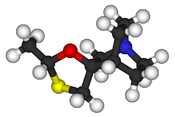Cevimeline
 | |
 | |
| Clinical data | |
|---|---|
| Trade names | Evoxac |
| AHFS/Drugs.com | Monograph |
| MedlinePlus | a608025 |
| Pregnancy category |
|
| Routes of administration | By mouth (capsules) |
| ATC code | |
| Legal status | |
| Legal status |
|
| Pharmacokinetic data | |
| Protein binding | <20% |
| Identifiers | |
| |
JSmol) | |
| |
| |
| | |
Cevimeline (trade name Evoxac) is a synthetic analog of the natural alkaloid
Sjögren's syndrome
.
Medical uses
Cevimeline is used in the treatment of
Side effects
Known side effects include
Contraindications include
angle closure glaucoma.[citation needed
]
Mechanism of action
Cevimeline is a cholinergic agonist.[2] It has a particular effect on M1 and M3 receptors.[2] By activating the M3 receptors of the parasympathetic nervous system, cevimeline stimulates secretion by the salivary glands, thereby alleviating dry mouth.
See also
- Pilocarpine — a similar parasympathomimetic medication for dry mouth (xerostomia)
- Bethanechol — a similar muscarinic parasympathomimetic with longer-lasting effect
References
- ^ PMID 15234277.
- ^ ISBN 978-0-323-47927-1.
- ^ "Cevimeline". MedicineNet. Retrieved 12 October 2007.
